Dee Estuary Birding
Monthly Newsletter...
March 2024
Newsletter
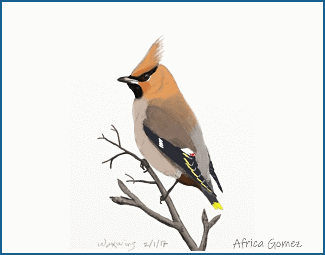
Highlights - March 2023 to February 2024
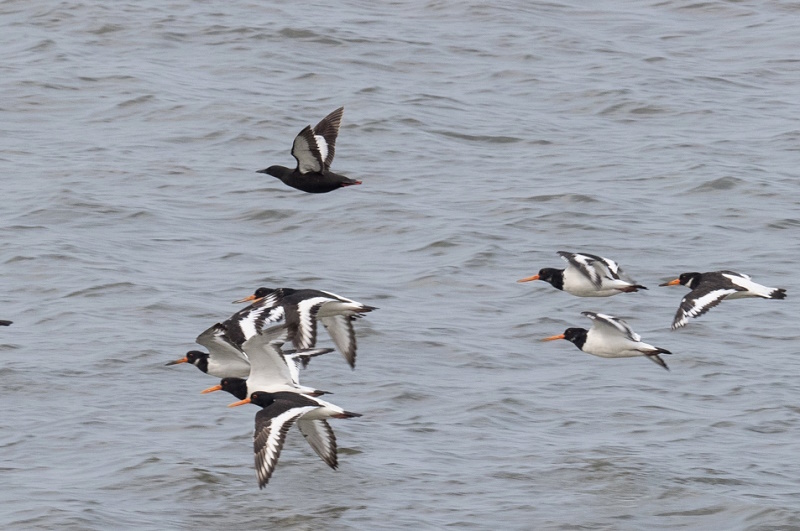
Here is my usual yearly summary on the 26th Anniversary of this Dee Estuary Birding website. I always enjoy looking back over the previous 12 months, and there is certainly plenty to write about.
Spring
Cold northerly winds and some thick snow in early
March meant that the spring migration was late - but the weather
changed, the 17th was a lovely spring day and brought in our first
Wheatears, Sandwich Tern, White Wagtail and loads of Stonechats
including over 30 at Leasowe Lighthouse. Five days later we were in for
a big surprise when four Alpine Swifts were seen, our first ever
multiple record for this species which is far from being annual in our
area - in total we reckoned eight different Alpine Swifts
were recorded in March.
Another unexpected multiple record of a rarity were two Black Guillemots at Hilbre on March 25th. Presumably it was one of these which was later seen in summer plumage off both Hilbre and North Wirral on many occasions right through to June. Amusingly, this bird seemed to think it was an Oystercatcher as it was frequently seen with them on the rocks at the north end of Hilbre!
RSPB Burton Mere Wetlands (BMW) had more than it's fair share of rarities in April with a Black-winged Stilt (later also at Talacre), a Gull Billed Tern and a Savi's Warbler. Four records of Blue-headed Wagtail was a good number for this continental race of Yellow Wagtails. The spring migration continued into early May with 33 Wheatears at Burton on the 1st and 184 Whimbrels at Heswall on the 2nd.
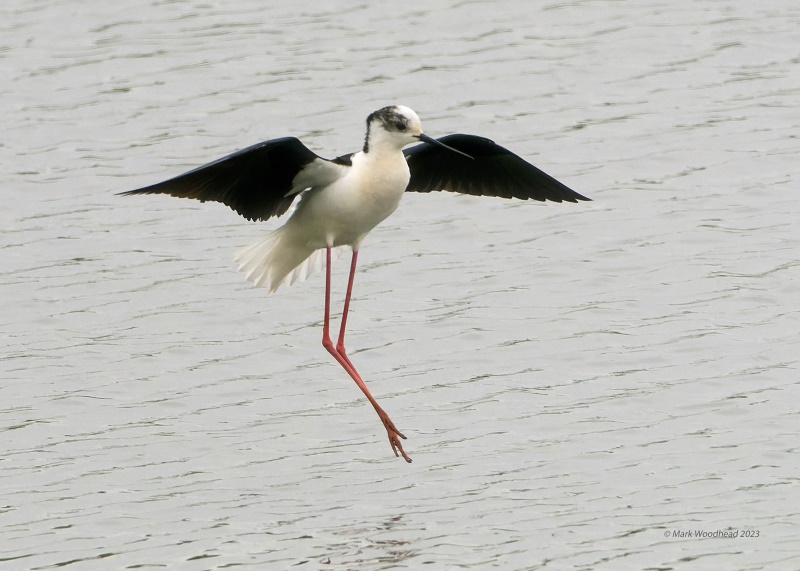
Summer
A White-tailed Eagle, which had been on the Mersey Estuary, flew over the Dee Estuary in June - it had a tracker so seen by a satellite but unfortunately not by any human. Two nice rairites in July were a Red-backed Shrike in the dunes between Gronant and Point of Ayr and a Night Heron at Burton Mere Wetlands. Some strong winds blew in three Storm Petrels.
In August the mud off Meols attracted Cheshire and Wirral's second ever Citrine Wagtail, and also several adult Curlew Sandpipers in various stages of moult.
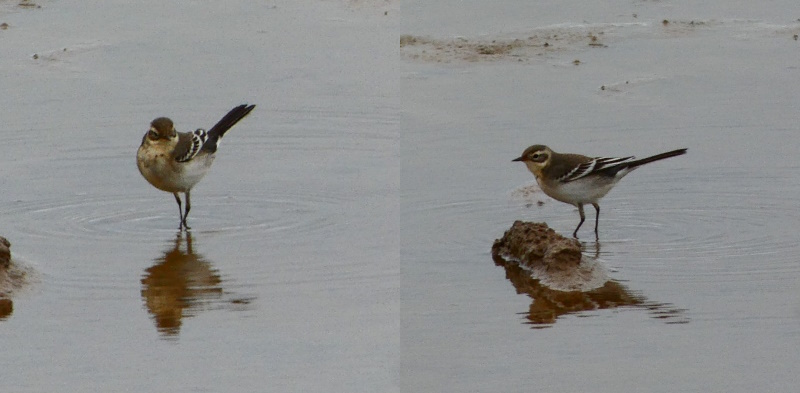
Autumn
September saw a good passage of juvenile Curlew
Sandpipers, 13 were at BMW for six days but probably the best views of
them were just off the West Kirby Marine Lake wall where the birds were
happily feeding just a few feet from the many people walking around the
lake.

A Baird's Sandpiper was a nice find off Hoylake, a
third record for the Dee Estuary. A few Leach's Petrels were seen in
the second half of September, we would have had a lot more if the winds
had blown in the right direction for a day or two longer - so we were a
bit frustrated!
A few Black Terns were spotted including five off Hilbre, and there was a high count of 190 Arctic Terns at Hoylake.
Cattle Egrets continue to increase and there were 19
at BMW in October, 13 Spoonbills were also present. The last day of
October saw a Pallas's Warbler at Talacre and one was at Hilbre just a
few days later in early November. Other nice rarities were a Richard's
Pipit and a Barred Warbler.
There was a big influx of Short-eared Owls into the country in November and we saw quite a few here including six off Denhall Quay early in the month. Disappointingly, numbers soon dropped and just one was seen in December. There were plenty of Marsh Harriers around including 18 at Parkgate on Nov 4th.
Winter
It was a Waxwing winter. And about time too, as the
last one was in the winter of 2012/13 (see
Species Spotlight - Waxwings).
We first saw a handful at the end of November with more around in
December including 10 by M&S Foodhall in Heswall. Up to 17 in
Saughall Massie at the end of December gave good views but the lack of
Rowan berries meant numbers remained low. But Waxwings also eat
Hawthorn berries and they found plenty on Halkyn Mountain amidst the
quarries west of Pentre Halkyn. The first report was of at least 50 on
Jan 24th and two days later it was reckoned over 180 were in the area,
and they remained there right through to the end of February.
So if they were
there for at least 30 days, and if we say, at a rough conservative
guess,
there were an average of 80 a day - that makes 2400 records (sum of
daily totals), more than the 2250 total records in the winter of
2012/13 which, until now, was regarded as the best Waxwing winter ever
in our area. Fantastic!
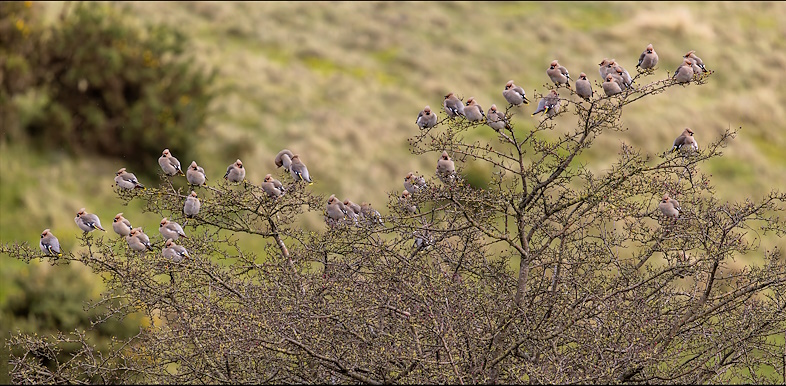
We had some nice ducks in January including a lovely
drake Smew both on Warren Farm at Talacre and, for one day, West Kirby
Marine Lake. There were up to three Long-tailed Ducks off Hoylake and
an American Wigeon at BMW, the latter was the rare 'Storm Wigeon'
variant with a white head - presumably the same one seen on Anglesey
earlier in the winter. A Slavonian Grebe was off Hilbre for a couple of
days then after a brief visit to West Kirby Marine Lake, visited the
Welsh side of the estuary near Bagillt. Six Snow Buntings were at Point
of Ayr and five at Gronant, and a Glaucous Gull flew along the Shore at
Meols.
February 12th saw one of the biggest tides of the
year which covered the marshes right up to Burton. In fact there were
at least three very high spring tides around that date giving a great
spectacle of birds including thousands of Pink-footed Geese and waders,
plus great views of Water Rails and both Hen and Marsh Harriers. Three
Short-eared Owls were at Decca Pools on the highest tide with six over
Burton Marsh four days later.

Richard Smith
Colour Ring Report
Curlew
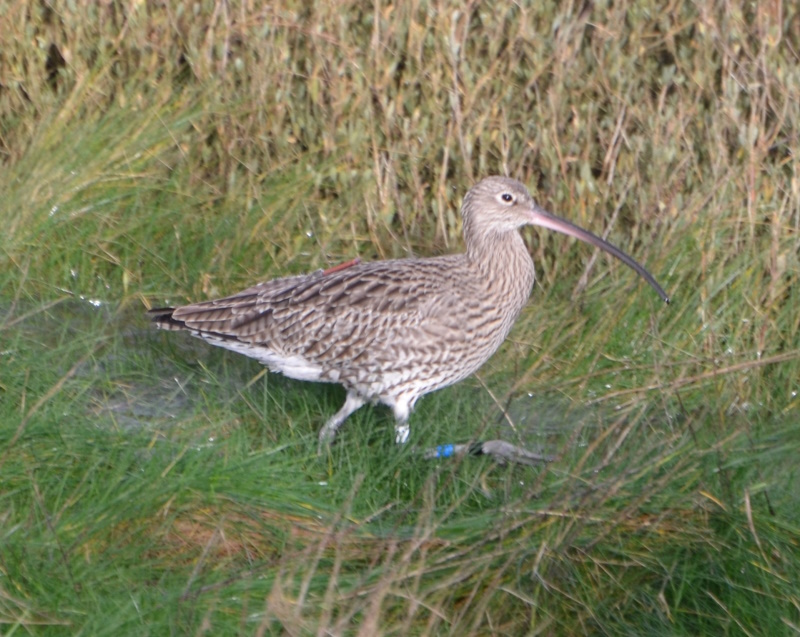
W/BN
with GPS transmitter
Recorded at Flint Castle on 14/01/2024 and featured in January's colour ring report. Since then I have received another map showing the movements of this bird as tracked by GPS over the whole of this last autumn and winter - see below (map kindly provided by Rob Foster). It's shows just how site faithful Curlews are with this bird hardly moving away from Flint Marsh and the adjacent mudflats
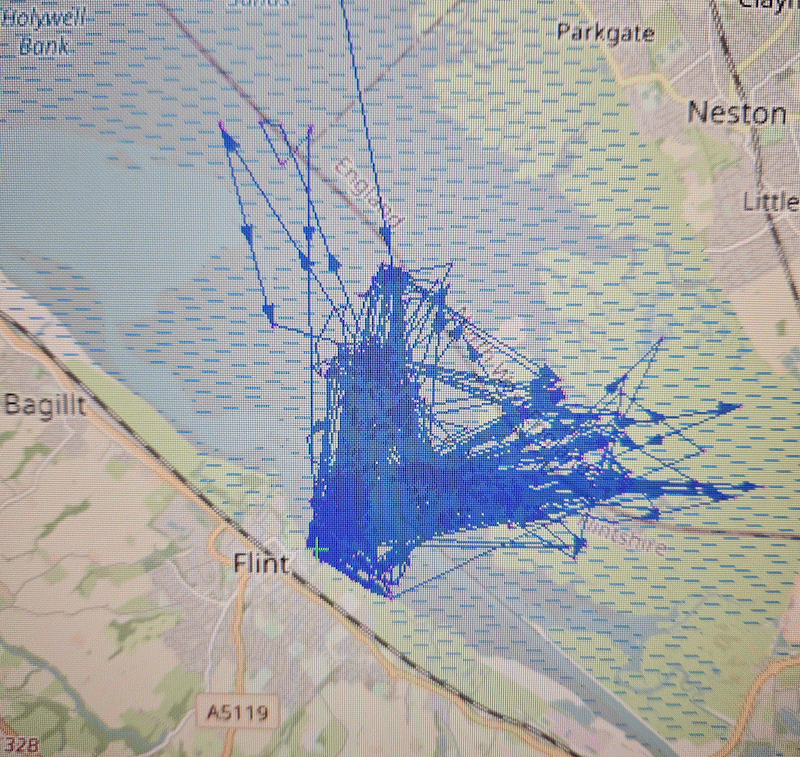
Bar-tailed Godwits
520 Bar-tailed Godwits on Hoylake Shore on
February 9th was an unusually high number and I was very pleased to see
four with colour rings.
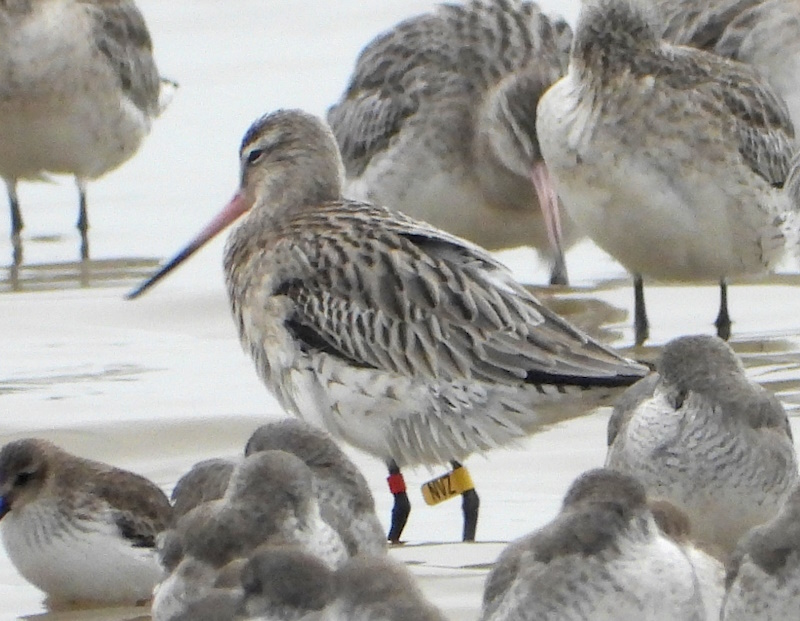
R-Yflag(NVZ)
Ringed at Revtangen, SW Norway, on 25/08/2020.
Recorded:
At Le Teich Reserve on the Atlantic French coast (about 20km SW of
Bordeaux) on 31/12/2020.
Dawlish Warren, Devon, on 06/01/2021.
Ainsdale on 25/05/2021.
Hoylake on 09/02/2024.
R-Yflag(CPA)
Ringed at Telemark, southern Norway, on 16/08/2021.
It was recorded at Seaforth, Birkdale and Thurstaston over the winter
of 2021/22.
Presumably it was a juvenile when it was ringed as it didn't breed the
following summer spending June 2022 at Ainsdale.
It was then seen several times along the Sefton coast including
roosting at Seaforth, with the last record that winter at Formby in
March. It returned to Seaforth in September 2023 and at Crosby in
October 2023. There were then no further records this last winter until
it turned up at Hoylake on 09/02/2024.
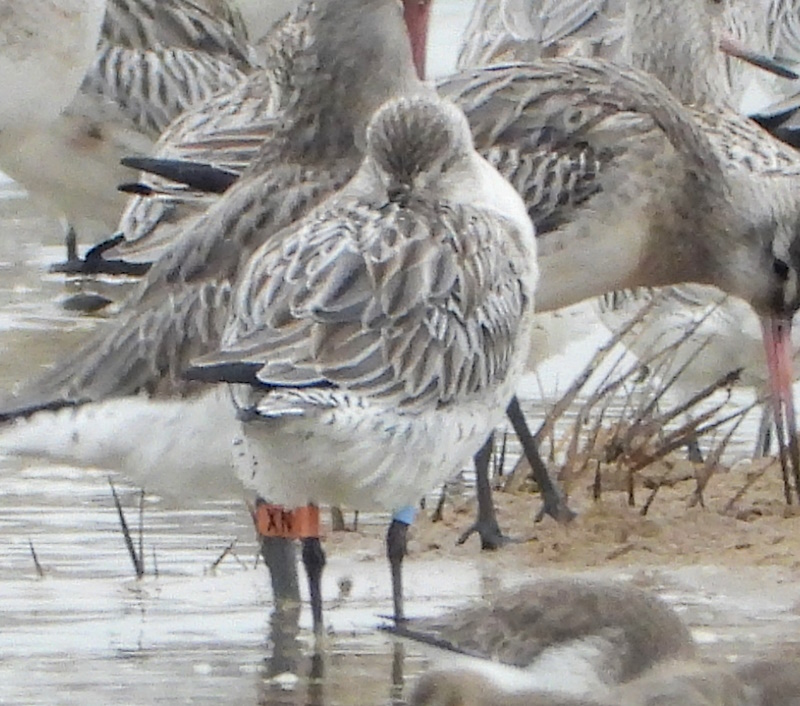
Oflag(XN) - P
Ringed at Altcar on 30/3/2018.
It returned to nearby Formby in July that year and remained in the area
until January 2019. There was a similar pattern from July 2019 to March
2020 when it was at Ainsdale.
Sightings then became more infrequent with sightings in November 2021
at Ainsdale and January 2023 at Formby before being recorded at Hoylake
on 09/02/2024.
Oflag(MC) - P
Ringed at Altcar on 30/3/2018.
First record was at Thurstaston in November 2018.
It was then seen 12 times along the Sefton coast between March 2019 and
December 2021 before being recorded at Thurstaston again in January
2022.
There was just one further record, at Formby in January 2023, before it
turned up at Hoylake on 09/02/2024.
Black-tailed Godwits
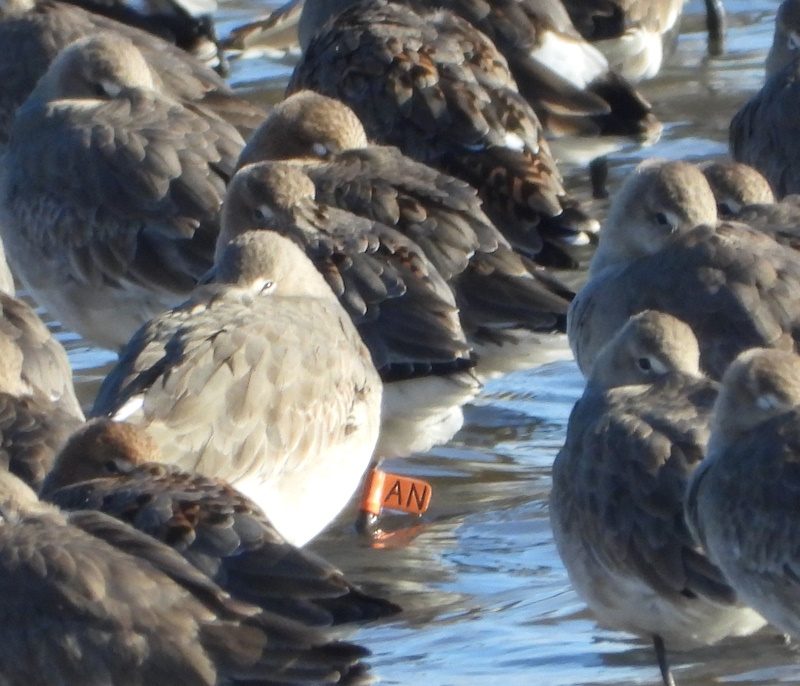
G - Oflag(AN)
Before November 2022 no Black-tailed Godwits had ever been colour
ringed on the west side of mainland Britain. But a new scheme using
inscribed Orange flags has changed that. Just one was caught and ringed
in Anglesey in November 2022 but now 20 more have been given orange
flags,
all of which were caught along the North Wales coast this last winter.
Remarkably, 10 of these 21 birds were seen in NW England in the last
week of February. These include five at Burton Mere Wetlands, the rest
being seen at Martin Mere, Conder Green and Leighton Moss. This clearly
shows that the godwits which over-winter in North Wales stage in
north-west England before they return to Iceland to breed.
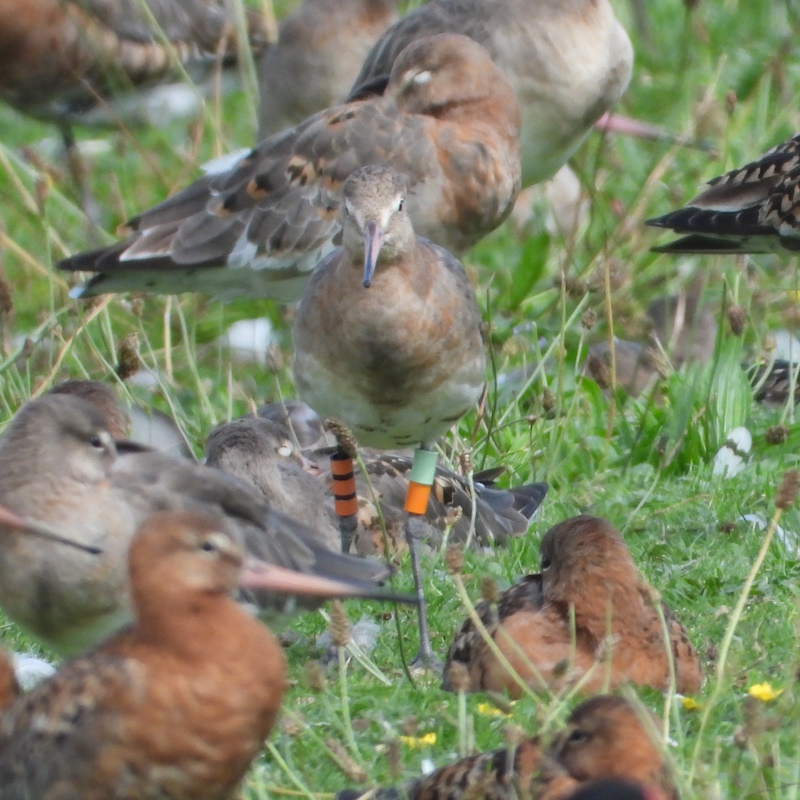
LO-O=
Ringed at Belfast Harbour in April 2021.
This bird, which has featured in previous Colour Ring Reports, has
spent the last three post breeding moult periods (2021 to 2023, July to
October) on the Dee Estuary being mostly seen at the Caldy Wildfowl
Collection. The spring moult, in March and April, sees it at Belfast
Harbour.
Until February 2024, there had been no records during the winter months
but it was recorded at Parque Natural de Bahia de Cadiz on 09/02/2024.
Very few of the Icelandic Black-tailed Godwit population make it that
far south so this one is particularly interesting.
Oystercatcher
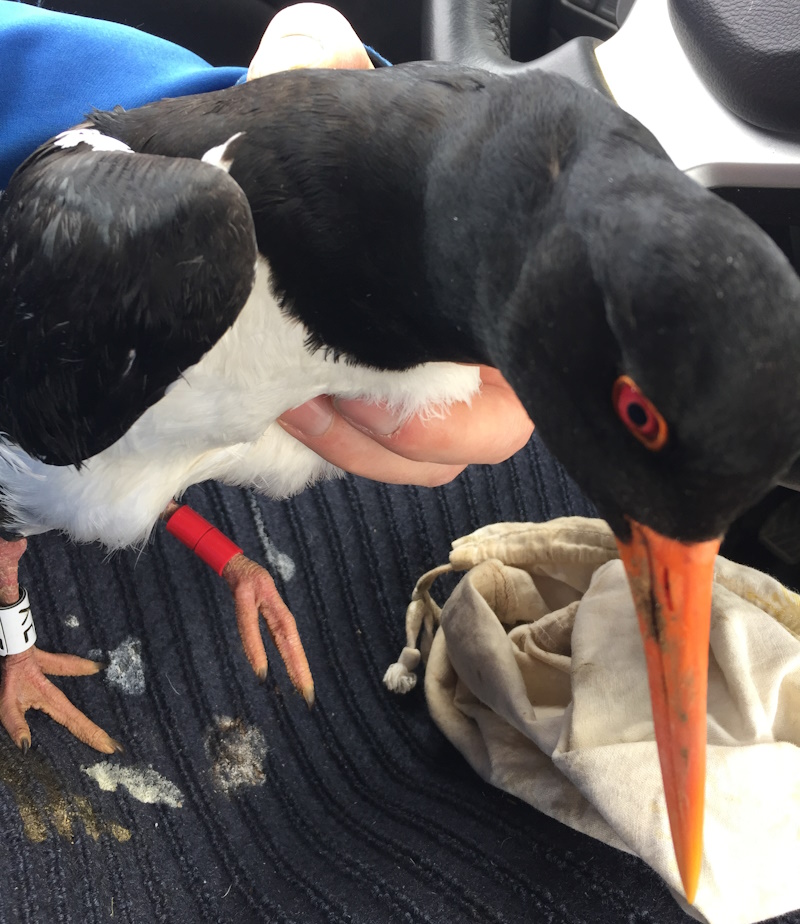
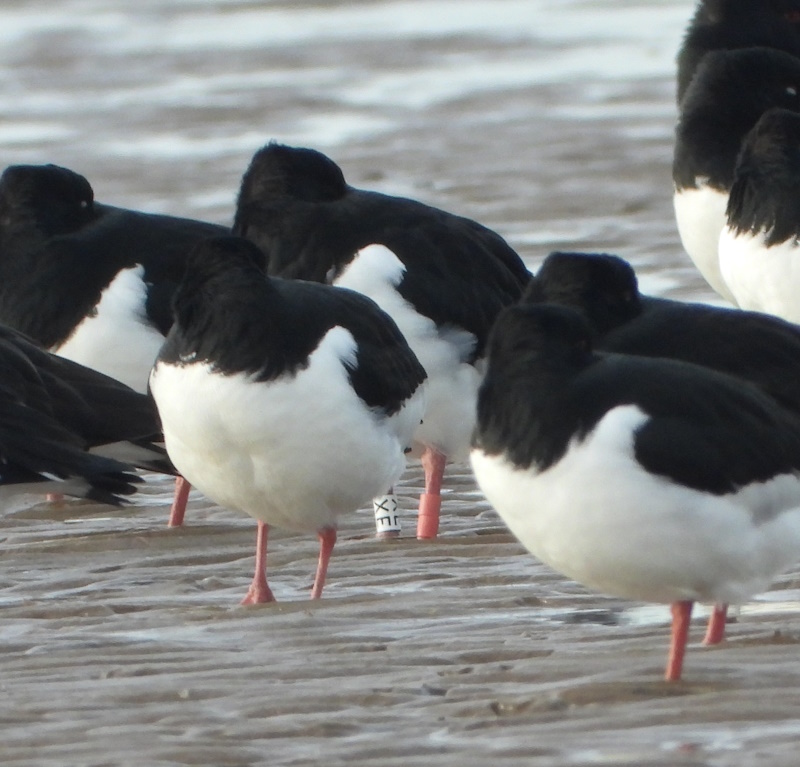
and bottom at Thurstaston, in February 2024 © Richard Smith
When I saw it I thought the rings on the left leg were orange, but they are actually faded red and you can see how bright red
they were in 2021. It's unusual for colour rings to fade but it does sometimes happen.
RR-W(XE)
Ringed at Selfoss, S Iceland in June 2021.
Recorded during the breeding season at the ringing location in 2022 and
2023.
Seen at Thurstaston on 07/02/2024.
This is what Boddi, the ringer, had to say: "This
bird had a new mate this year. His nest were predated by arctic fox. I
had a camera at the nest and if I remember correctly then the fox came
same time when chicks were hatching. This summer we had a high
predation in South Iceland, mostly by arctic fox."
Dunlin
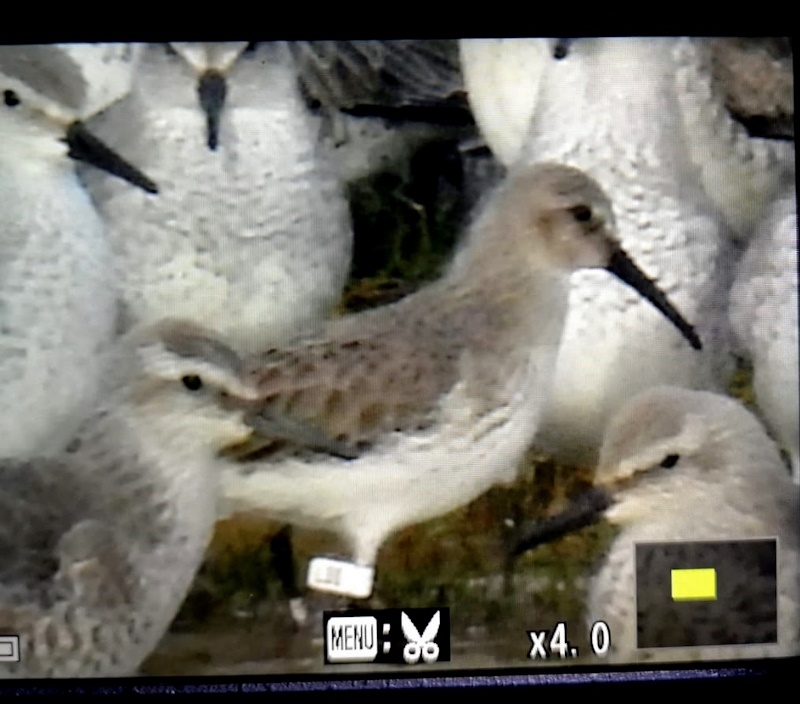
White flag (L31)
Ringed at Gdansk, Poland, on 13/07/2020.
Recorded at Hoylake on 10/02/2024.
The Polish Ringing Group have ringed many thousands
of Dunlins over the years, this is the 19th we've recorded here on the
Dee
Estuary and north Wirral.
Knots
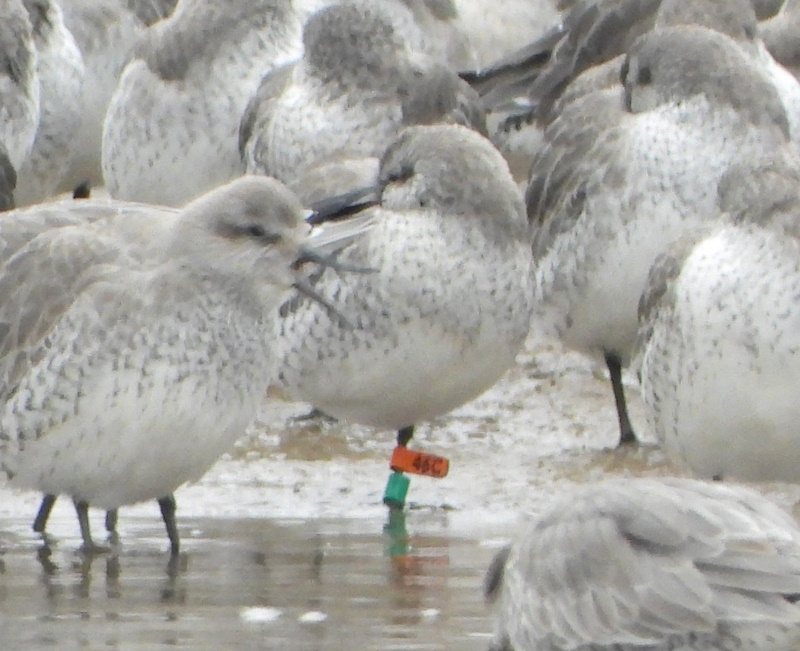
Fifteen Knots were caught and fitted with orange
flags at Hoylake on 11/02/2024. Subsequently two of these were seen at
Meols (including 46C above) and two on Crosby Beach.
Colour Rings were recorded by Richard
Smith, Stephen
Hinde, Tony Ormond, Richard du Feu, Steve Williams, Alan Hitchmough
(Merseyside Ringing Group), Alex Jones, Kieran
Carroll and David Thompson.
Richard Smith
February Bird News
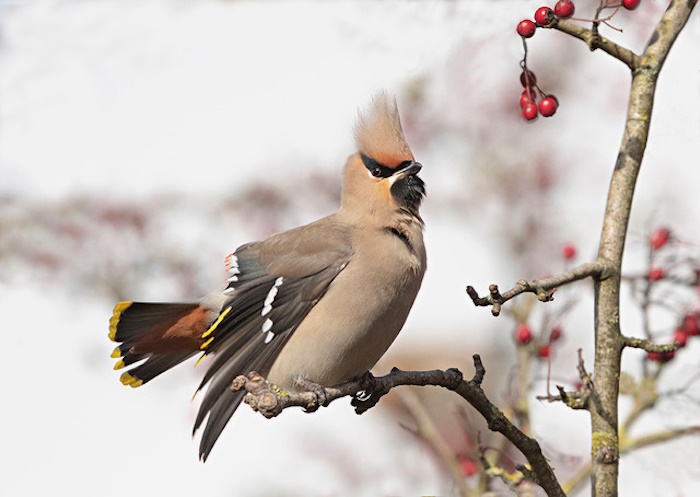
It was certainly a good Waxwing winter. Over 180
were at Halkyn Mountain early in the month with around 40 at the
month-end.
The predicted spring tides from the 11th to the 14th produced some big
tides which covered the marsh right up to Burton Marsh.
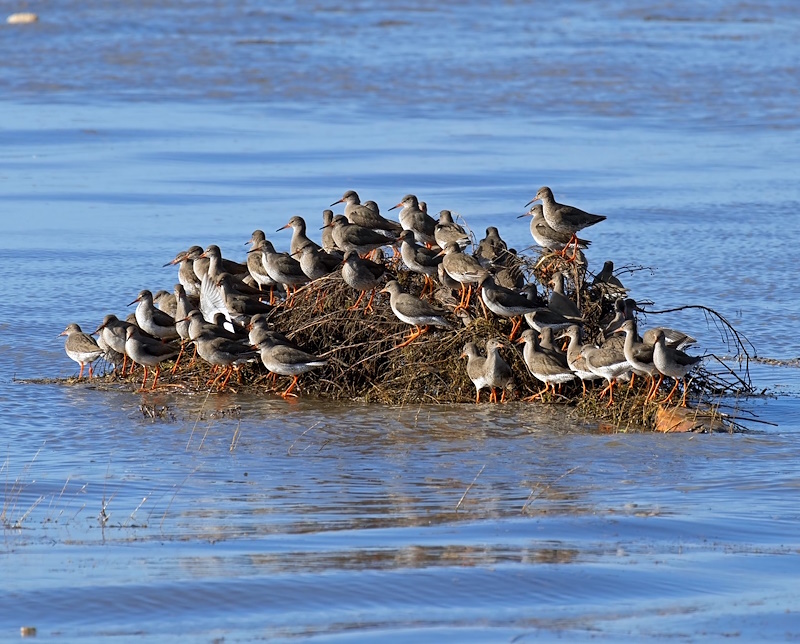
During these very high tides there was the usual spectacular numbers of
wildfowl and waders, these included two European White-fronted Geese as
well as many thousands of Pink-footed Geese. Short-eared Owls were
disappointingly absent from Heswall and Parkgate marshes but three were
around the DecCa Pools on the 12th, and six were on Burton Marsh on the
16th, with one or two around the Denhall Quay/Decca Pools area most
days since.
It was good to see plenty of Hen Harriers through
the month and these included four grey males on the outer Burton Marsh
on the 1st, later there were records of at least two ringtails, so six
is a decent total. Lots of Marsh Harriers also, with a max count of at
least eleven on the 1st.

Wader numbers have been relatively low this winter but it was good to
see 520 Bar-tailed Godwits and 11,000 Dunlins at Hoylake on the 9th.
2,500 Black-tailed Godwits were at Burton Mere Wetlands towards the end
of the month.
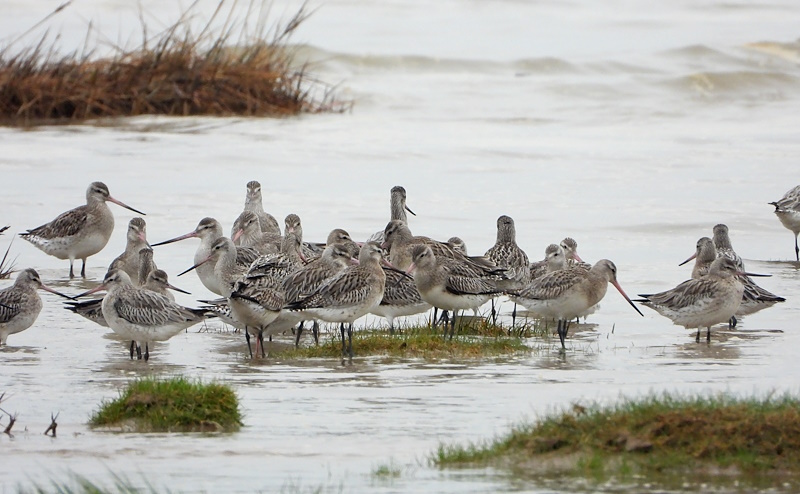
The first Avocet arrived back at Burton Mere Wetlands on the 11th, and
I counted 43 there on the 26th. Two Bitterns were recorded there on
several dates, hopefully they'll stay to breed.
Out to sea there were three Long-tailed Ducks off Hoylake on the 7th and 12 Little Gulls off Leasowe Gunsite on the 28th, on the latter date there were large numbers of Common Scoters off Hoylake roughly estimated at 10,000 with around 500 Great Crested Grebes also.
A flock of at least 25 Twites were frequently seen
on Flint Marsh and six Snow Buntings were on the beach at Point of Ayr.

What to expect in March
March
sees the return of spring and the return of the spring migrants. Below
is the table for 2023 (and the previous two years) showing the first
sightings for a selection of species.
If you see an early migrant please email
 and,
if it's a first,
I'll put it in the 2024 table.
and,
if it's a first,
I'll put it in the 2024 table.
| Species | 2023 | Location | 2022 | 2021 |
|---|---|---|---|---|
| Sand Martin | 15th March |
Gronant | 11th March | 5th March |
| Wheatear | 17th March |
Burton/Little Eye | 9th March |
28th Feb |
| White Wagtail |
17th March | Leasowe | 12th March |
16th March |
| Swallow | 24th March | Leasowe | 15th March | 18th March |
| Willow Warbler |
25th March |
Burton | 29th March |
23rd March |
| House Martin |
April 1st |
Burton |
23rd March | 27th March |
| Swift | April 5th |
Greenfield |
28th April | 16th April |
| Whitethroat | April 10th |
Decca
Pools |
10th April | 10th April |
| Cuckoo | April 24th | Leasowe
|
21st April | 24th April |
There is another set of big high tides from the 10th to the 14th. The one on the 12th, at 10.3m (Liverpool) is predicted to be the biggest tide of the year which can be seen in daylight hours - that should be interesting if it coincides with a tidal surge! There will still be lots of over-wintering birds about.
As well as the species listed above we can expect to
see our first Ring Ouzels, Sandwich Terns, Little Gulls and Ospreys.
Always an exciting time specially if we get some mild weather and
southerly winds towards the end of the month. We usually see a strong
passage of Stonechats along North Wirral, last year was exceptional.
Rarities are to be expected - last year we had an influx of Alpine
Swifts as well as a Lapland Bunting and Long-billed Dowitcher.
Forthcoming Events
March Highest Spring Tides (Liverpool)
Also see Tides page.
10th March, 11.02hrs (GMT), 9.9m.
11th March, 11.45hrs (GMT), 10.2m.
12th March, 12.27hrs (GMT), 10.3m.
13th March, 13.08hrs (GMT), 10.2m.
14th March, 13.49hrs (GMT), 9.8m.
Forthcoming Events
Also see events at https://events.rspb.org.uk/deeestuary